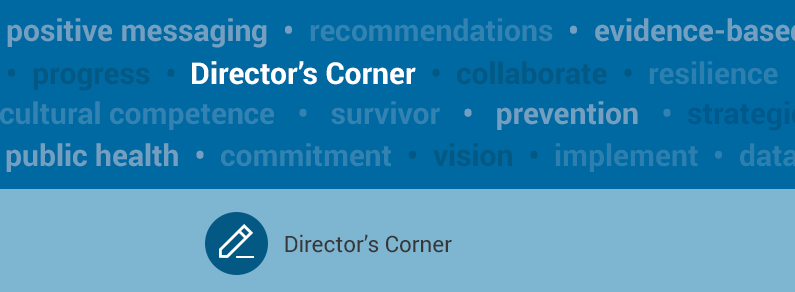National Action Alliance for Suicide Prevention: Reflections on a Groundbreaking Year
December 02, 2011

I would like to occasionally give the readership a chance to hear from some of the wonderful staff we have serving SPRC stakeholders. For this month, I would like to introduce Katie Wootten Deal, the Associate Director of a team at SPRC that supports the operations of the National Action Alliance for Suicide Prevention, the public-private partnership advancing our National Strategy for Suicide Prevention. – Jerry
I am often asked why I chose to work in suicide prevention. My answer: I have found a field where my mind meets my heart – a field full of intelligent, capable leaders who are passionate about preventing such a complex, emotional outcome from ever happening; about intervening when signs and symptoms emerge; and about providing crisis support and other resources after a suicide has occurred in a community. The members of the National Action Alliance for Suicide Prevention (Action Alliance) embody the blend of intellect, experience, and fervor that is needed achieve its mission, and I am incredibly humbled and excited to walk alongside them and help support their work.
The Action Alliance is a public-private partnership established to gain the kind of national attention, legitimacy, support, momentum, and resources necessary to ‘move the needle’ for suicide prevention (i.e. to reduce the burden of suicidal behavior in our nation). Its launch represented another significant milestone for our burgeoning field. Its aim – to advance specific, high-priority objectives of the National Strategy for Suicide Prevention that require leverage and coordination at the national level – will benefit our respective organizations, systems, and communities. Its work – conducted by high-level, energetic, and resourceful public- and private-sector leaders from across the country – is pioneering. And its inaugural year was groundbreaking.
Secretary John McHugh of the Army, the Action Alliance’s Public Sector Co-Chair, recently lauded the “collaboration between the government and the private sector” as “one of the keys to [the Action Alliance’s] success.” This type of collaboration among its members is incredibly important for advancing a comprehensive approach to something as complex as suicide, something that no one individual, organization, or sector can tackle alone.
During its first year, the Action Alliance has developed great momentum to form and enhance its membership and infrastructure, to advance its mission, and to form a Sustainability Committee to strengthen its newly-established foundation. Its Executive Committee met regularly to discuss how to leverage their agencies, organizations, and systems to advance suicide prevention; discuss how to integrate suicide prevention policies and practices into healthcare reform; and establish a goal and priorities should be for year two and beyond (stay tuned for more information about these priorities).
The first-year accomplishments of its 12 task forces laid a foundation for enhancing our country’s suicide prevention infrastructure and promoting suicide prevention among high-risk populations and in specific settings. The task forces reviewed existing data sources on suicidality to determine how to improve our data’s accuracy and timeliness; formed a plan for developing training guidelines for various professions that support suicidal patients; implemented the ‘Partners with Care’ program in five states to link local faith-based communities with returning National Guard veterans; promoted suicide prevention awareness and education to the entertainment community and the general public; gathered information on suicide prevention needs, concerns, programs, and practices among American Indian and Alaska Native communities; and identified the importance of addressing needs of lesbian, gay, bisexual, and transgendered people across the lifespan in our research and prevention efforts.
So what is SPRC’s role in the Action Alliance? We house its Secretariat, a team that supports the operations of the Action Alliance, and we are deeply honored to do so. We build members’ capacity to carry out their work, help organize their meetings, and implement strategic communications plans to get the word out about their extraordinary work through such vehicles as a website, press releases, newsletter, annual report, and social media. And SPRC’s director, Jerry Reed, serves on the Executive Committee and co-leads a task force.
Looking ahead to year two and beyond, the Action Alliance has established a goal to change systems and policies that have the power to affect suicide outcomes over the long term. How will accomplish this goal? Here are some examples:
- Release a revised and updated National Strategy for Suicide Prevention to acknowledge all of the advances that have been made in our field in the last decade and chart the course for the years ahead.
- Provide a prioritized research agenda for the suicide prevention field that will strategically guide our research efforts.
- Catalyze an overhaul in how we provide clinical care for patients who at highest risk of suicide by laying out recommendations for national leaders, health and behavioral health providers, and health plans.
- Enhance the provision of suicide prevention within our juvenile justice system through heightened awareness, improved collaboration between mental health and juvenile justice, recommendations for future research, and expanded training and prevention programming.
- Develop a compelling case for employers to support suicide prevention in our country’s workplaces, home to adults in the middle years – the population with the highest number of suicides per year.
Senator Gordon H. Smith, a survivor of his son Garrett’s death by suicide and the Private Sector Co-Chair of the Action Alliance, eloquently stated: “I am encouraged by the progress we are making. The [Action] Alliance has brought together over 200 highly respected national leaders representing 190 organizations and very quickly formed 12 task forces. With the help of these dedicated members, the Action Alliance is moving toward a nation free from the tragic experience of suicide.”
As the Action Alliance begins its second year, we would love to hear from you about the impact of its work that you have already seen, or that you hope to see in the future. If year two is anything like year one, I’ll feel just as exhausted, exhilarated, and ready… to do it all over again.
